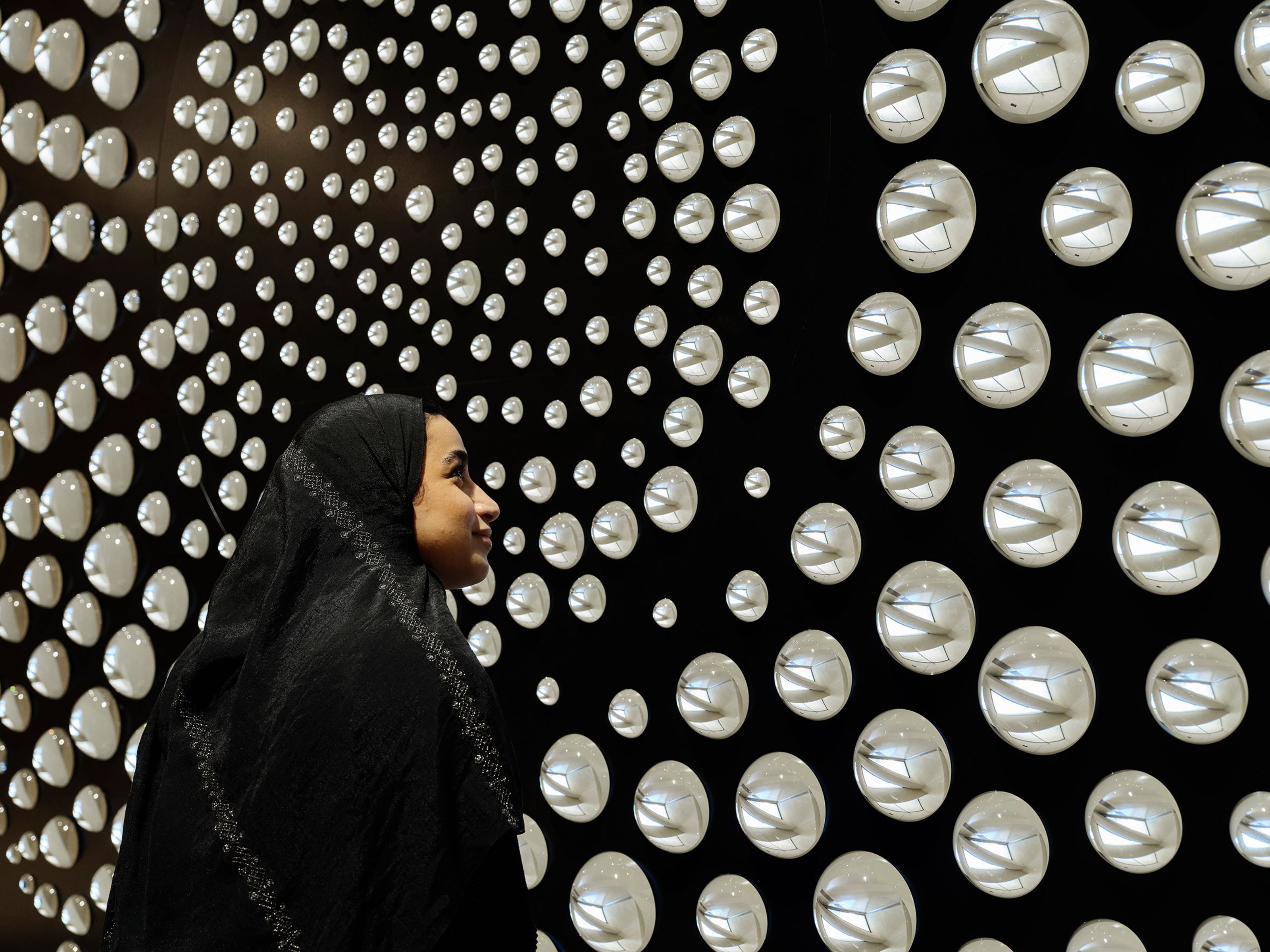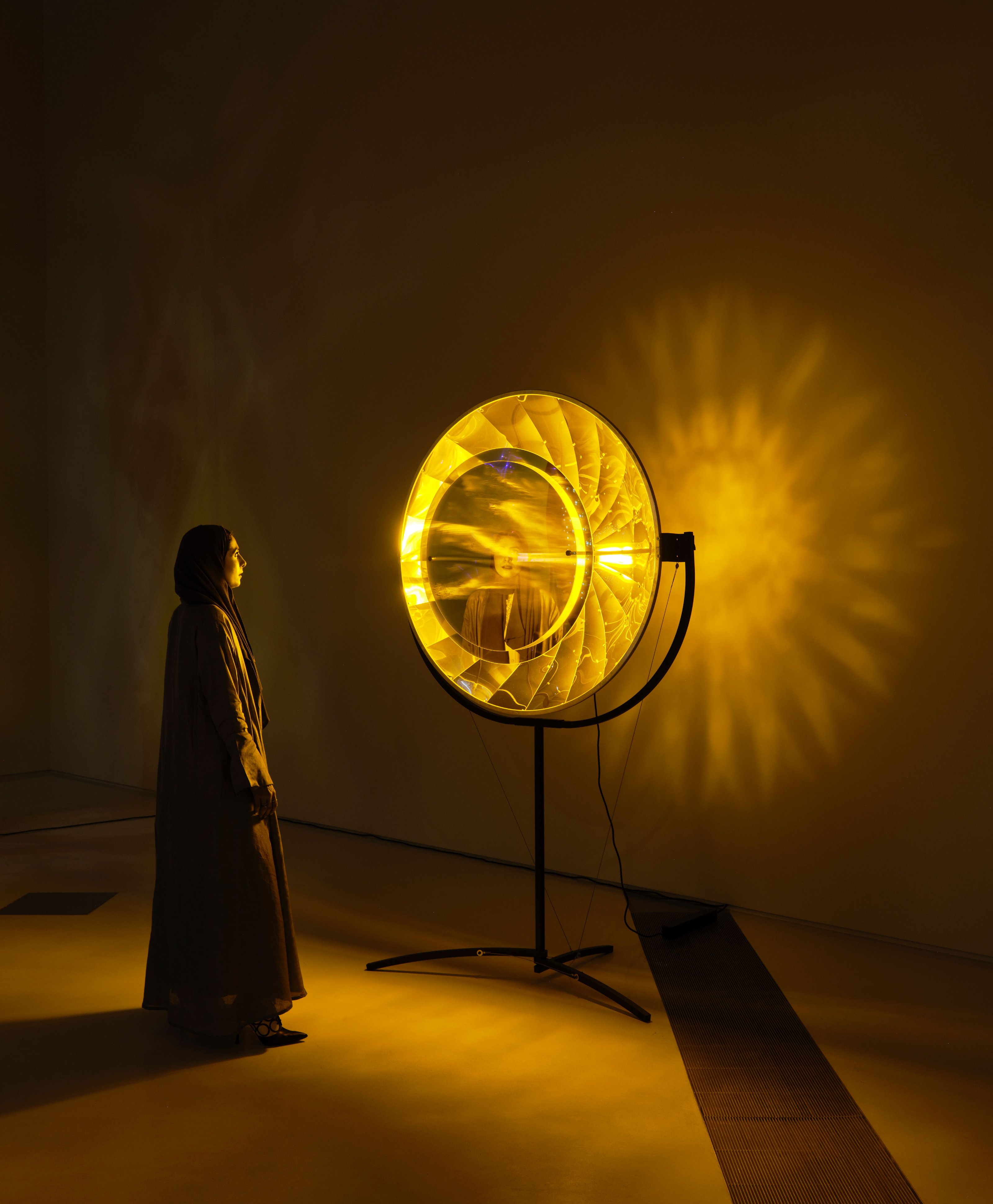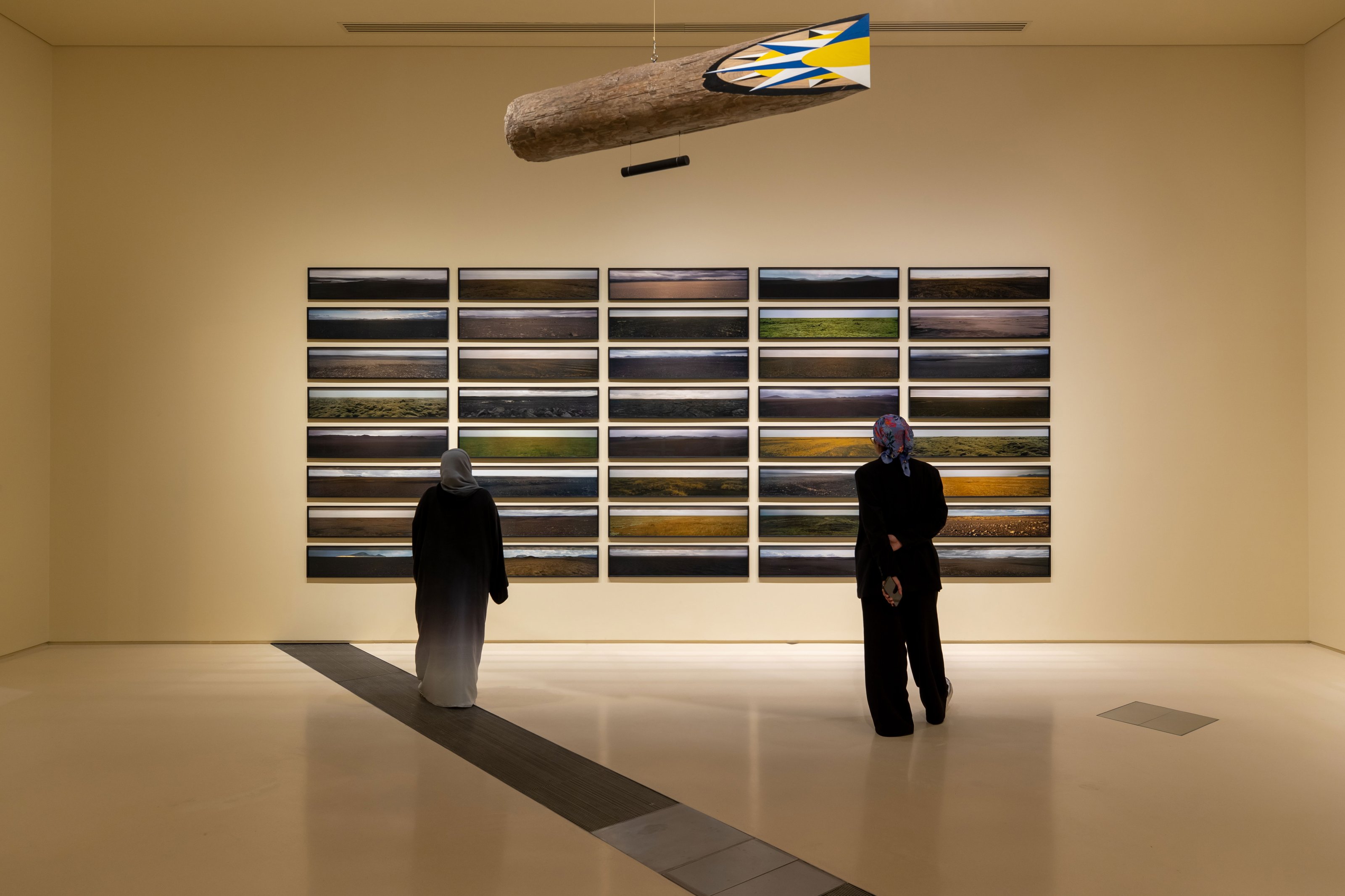Olafur Eliasson opened his first solo exhibition in the Gulf region this March at the National Museum of Qatar. The curious desert runs from the 19th of March to 15th of August with the objective of spotlighting nature’s intrinsic value. The exhibition’s viewpoint centers on the environment, something paramount during a global climate crisis. However, Eliasson’s artwork comes only a few months after the World Cup’s sustainability scandal. Critics could allege that the exhibition is an example of performative sustainability or artwashing. Yet, Eliasson’s pieces within the Qatari context require a deeper examination.

Eliasson’s work proposes that nature is a creative agent. The exhibition is divided into two parts: one indoor exhibition that gives a background about the artist’s past career and an outdoor section that interacts directly with Qatar’s natural biome. Indoors, optical delights prevail; Algae window (2020), a flat circular structure, employs different-sized glass spheres all throughout, mimicking the architecture of diatoms, carbon-absorbing algae. For their part, the famous glacier melt series (1999/2019) show the rapidly advancing effects of global warming. Though varied, these works still carry an environmental theme, a throughline that leads to the outdoor space consisting of twelve pavilions.
Olafur Eliasson / Solar-drawing observatory, 2023
Olafur Eliasson / Solar-drawing observatory, 2023
Olafur Eliasson / Rainbow incubator, 2023
Olafur Eliasson / Future eye seeing now, 2020
Olafur Eliasson / Drawings from Saltwater-drawing observatory comprises, 2023.
Olafur Eliasson / Map for navigating memory, 2022.
The curious desert, installation view. National Museum of Qatar, Doha, 2023. Photography by Anders Sune Berg.
Each open-air installation uses natural elements to interact with human-made structures and create art. Two Solar-drawing observatory (2023) pavilions direct the sun through glass spheres that act as lenses, allowing focused sun rays to burn circular marks onto moving sheets of paper, while the Saltwater-drawing pavilion (2023) utilizes wind-driven, suspended ropes dipped in pigment and lagoon water to paint portraits of the weather conditions onto circular canvases. The Rainbow incubator (2023) manipulates sunlight through mirrors and shadows to produce a perfectly circular rainbow. And Your oil-spill garden (2023) takes residual tar from an oil spill and displays it in a circle.

The outdoor exhibit exists just outside the limits of the Al Thakhira Mangrove Nature Preserve. The pavilions, each circular and independent, are scattered through a small piece of the desert. They center the fundamental components of the mangrove ecosystem—salt water, wind, and sun—which develop on the coast of the arid territory, forming strips of green where the desert meets the sea.1 Eliasson portrays these components as creative agents for artistic expression, proposing that art can be found everywhere around us. The curious desert’s display of the landscape’s creativity aims to sensitize spectators to nature’s inherent value. Eliasson unveils the Qatari landscape’s grandeur, innate importance and singularity, all to, in his words, “make invisible phenomena visible and palpable.”2
Such a mission is particularly significant in Qatar, a country that possesses large hydrocarbon reserves while suffering from water shortage. Eliasson’s exhibition offers a perspective that frames landscape as much more than an economic resource. By confronting people with their surroundings3, nature becomes a being of its own. Qatar has made attempts to recognize the importance of the environment through recent endeavors. Last year, the country famously set out to host the first carbon-neutral FIFA World Cup in history,4 signaling the beginning of a new era where respect and preservation of surroundings become part of the equation. Yet, things did not pan out as expected, and critics quickly pointed out these policies’ flaws.
Slow solar event, 2023
Slow solar event, 2023
Saltwater-drawing observatory, 2023
Saltwater-drawing observatory, 2023. Detail.
Saltwater-drawing observatory, 2023. Detail.
Installation view: Olafur Eliasson / The curious desert, near the Al Thakhira Mangrove in Northern Qatar, 2023. Photography by Anders Sune Berg.

The 2022 FIFA World Cup took place from November 20th to December 18th—and Qatar was hosting. From the beginning, the event saw itself tarnished with non-stop controversies. Amongst these were the claims that the 2022 World Cup would be the first carbon-neutral event of its kind, which triggered immense criticism and backlash. Organizers promised to reduce carbon emissions to the minimum while offsetting the inevitable ones by purchasing carbon credits.
Carbon Market Watch, a non-profit watchdog organization specializing in carbon credits, questioned the computations of the event’s carbon footprint. They emphasized that emissions had been calculated over the entire 60-year lifespan of the stadium,5 resulting in a favorable number. Other critics questioned the effectiveness of purchasing carbon offsets, as they do not actually remove carbon from the atmosphere.6 Reports also highlighted the high number of shuttle flights that carried people to and from Qatar, which only resulted in even more carbon dioxide emissions.7
Though there is still no tangible consensus on the total 2022 World Cup emissions, these concerns are certainly worth acknowledging. Large-scale events rarely put enough effort into being greener, and neither do states. Yet, much criticism against Qatar’s World Cup failed to take into account Qatar’s unique environmental and sustainability challenges, as well as its position on the international stage. These factors complicate the picture.

Though sources have recently pointed out Qatar’s successful carbon reduction programmes—such as cutting 9,000 tonnes from its total World Cup emissions8—the country has an unflattering environmental reputation, with 70% of total government revenue coming from natural gas and oil.9 With this perspective, it is reasonable to question the motives and relevance of bringing Eliasson’s environmental artwork to Qatar. To understand why Eliasson belongs in today’s Qatar, we need the whole context.
It is tempting to precipitously jump to conclusions, but one must first consider Qatar’s idiosyncratic circumstances. The country suffers from a severe water shortage.10 Half of its drinkable water comes from the ocean, distilled through a desalination process that is extremely energy-intensive. Qatar’s water scarcity problem poses a challenge to its carbon reduction goals. And whilst more sustainable solutions are being looked into,11 the country’s resource condition might slow down its transition to an environmentally-friendly future. Indeed, for valid reasons.
That is not to say that calling out the country’s energy-related flaws is useless. Were it not for objections from the international community, many current initiatives might never have been proposed. Nevertheless, it would be irresponsible to ignore the ways in which the narratives that condemn Qatar’s oil economy fit all too well in the West’s hypocritical outcries against environmental destruction.
It is difficult to evade the manner in which leaders from these regions speak of the situation. U.S. representatives, for example, continue to insist on the role of countries like China in the climate emergency,12 ignoring the U.S.’s own historic contribution to global warming.13 Of course, all countries should be responsible for their environmental impact. Be that as it may, there is something to be said about unfairly expecting the Global South to immediately shift towards more sustainable operations14 while the West profits from its long history of oil use and continuously fails at reaching its own climate goals.
The point here is not to discredit criticisms of Qatar’s environmental approach but to challenge its framing, which overlooks historical development and local conditions. This allows one to see the bigger picture, to see the country beyond the myth of a monstrous fossil fuel giant, and to understand it as a state on its way to development, where resource constraints inform its sustainability. Hence, Eliasson’s exhibit on the Qatari desert might not be so incongruent after all but could be understood as part of the country’s efforts to reach sustainability.
The curious desert, installation view.

Eliasson directly appeals to Qatar through works installed in The curious desert. The previously mentioned Your oil-spill garden calls the viewer’s attention to the environmental consequences of an oil-dependent economy. The piece is a call for action,15 urging countries of the Gulf to diversify their sources of energy and income. And Qatar putting it in its own soil reveals an engagement to improve.
The exhibition represents a change in perspective. Olafur Eliasson places the environment front and center, with most pieces concerning themselves with nature as a creative agent. The artist sets out to shine a light on the power of landscape outside of humanity and as containing its own inherent value.
This viewpoint is similar to the one that sat at the core of the 2022 Venice Biennale,16 where curator Cecilia Alemani captured the cultural zeitgeist of contemporary times, demonstrating the Anthropocene’s limitations in solving the climate crisis came into question. The Anthropocene is the unofficial geological epoch in which we currently find ourselves, defined by human activity’s impact on the planet’s climate and ecosystems.17 This human-centric state of mind has contributed to today’s precarious climate, hence the art world’s preoccupation with what a post-anthropocentric era might look like.18
Ecocentrism is a much wider view of the world than anthropocentrism, as it “encourages us to see the rest of life as our kin,”19 inevitably leading us to reflect on our extractive living and its need for correction. Eliasson’s exhibition proposes a move away from an anthropocentric understanding of art, performing a shift and aiming to universalize it.
The curious desert is charged with transformative energy. And that may be precisely what Qatar needs to continue improving its infrastructures. Eliasson himself is deeply engaged with sustainability—he aims to make his studio carbon neutral20—so his art’s presence in Qatar is an extension of just that. The exhibition is a purposeful opening of conversations in a place where oil is so central that a change of perspective might be the only way to dethrone it. His art emphasizes the significance of such ideas circulating around the globe, especially where they might catalyze the most dialogue.